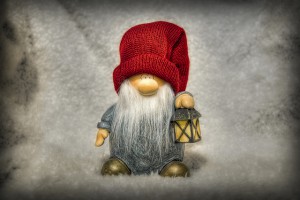Sprites of Christmas Posted by Bjørn A. Bojesen on Dec 25, 2014 in Traditions

A Scandinavian nisse. (Thanks to Anders Palovaara at Flickr.)
If you go to Skandinavia in desember, you’ll most certainly encounter little men (and women) with pointy røde luer (red caps) everywhere: In butikker (shops), in private homes, på tv [paw teh-veh] (in television). No, you’re not mad! Say hello to the nisser…
The typical nisse looks like an old man with a langt, hvitt skjegg [langt vitt shegg] (long, white beard) – except that he’s really small, like a child or even a rabbit. He’s wearing traditional clothes such as an ullgenser (woolen jersey). He’s often got tykke, røde kinn (fat round cheeks) and a jovial look. I think you wouldn’t mind having a grandfather like that! 🙂 On top of his head the famous nisselue looms large. It isn’t just a red version of a wizard’s hat – there typically is a white or red dusk (tuft) at the end.
Originally, a nisse was a kind of mythical being that helped farmers on their gård [gore] (farm). If the farmer didn’t treat him well, he could avenge himself by making sure that the goat gave birth to a kid with two heads – that kind of thing. In the Norwegian countryside people still talk about nisser; on the day before julekvelden (Christmas Eve, December 24th), traditional farmers will go out in the låve (barn) and place a skål grøt [skawl grert] (bowl of porridge) there so the local nisse won’t get hungry & angry…
In the towns and cities nisser are mostly associated with jul (Christmas) and moro (fun). Sometimes they’re mixed up with Julenissen (Santa Claus/Father Christmas). He was introduced to Scandinavia from the US, though, and hasn’t got very much in common with the Scandinavian nisser – except that they all wear red caps. Nisser aren’t just old men; there are also nissekoner (nisse wives) and nissebarn (nisse children).
Nisser make dark nights bristle with liv (life), and I can’t imagine Christmas without them. One of the most beloved julesanger (Christmas songs/carols) for children starts like this:
På låven sitter nissen med sin julegrøt,
in the barn the nisse is sitting with his Christmas porridge,
så god og søt, så god og søt.
so good and sweet, so good and sweet.
Han nikker, og han smiler, og han er så glad,
he’s nodding, he’s smiling, and he’s so happy,
for julegrøten vil han gjerne ha.
’cause the Christmas porridge he really wants.
God jul! [gohd yule]
Merry Christmas!

Build vocabulary, practice pronunciation, and more with Transparent Language Online. Available anytime, anywhere, on any device.
About the Author: Bjørn A. Bojesen
I was born in Denmark, but spent large parts of my childhood and study years in Norway. I later returned to Denmark, where I finished my MA in Scandinavian Studies. Having relatives in Sweden as well, I feel very Scandinavian! I enjoy reading and travelling, and sharing stories with you! You’re always welcome to share your thoughts with me and the other readers.



